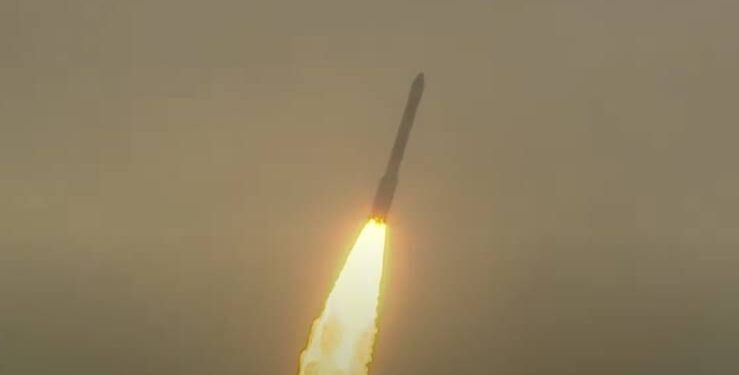ISRO’s PSLV-C61 Rocket Fails Due to Third Stage Anomaly, EOS-09 Satellite Lost

PSLV-C61 Rocket Fails Due to Third Stage Anomaly, ISRO’s EOS-09 Satellite Lost
India’s trusted backbone the PSLV, faced a rare issue during the launch of the PSLV-C61 mission on May 18, 2025 , which was supposed to put the EOS-09 satellite into orbit. Everything seemed to be going smoothly at first, with the rocket clearing the initial flight stages without any issues. But then, unexpectedly, the rocket strayed off its planned path mid-flight. Because of this sudden deviation, the mission couldn’t deliver the satellite to its intended orbit, indicating an unexpected glitch for ISRO’s normally steady launch vehicle. Initial findings indicate a failure in the third-stage flex nozzle system as the probable reason for the failure.
A Smooth Start That Ended Abruptly
The PSLV-C61 lifted off at 5:59 AM IST from the Satish Dhawan Space Centre from Sriharikota. Standing is about 44.5 meters tall and was carrying the EOS-09 satellite, which is a radar-imaging satellite designed for high-res for determining all-weather observation. The rocket’s first stage (PS1), powered by solid fuel, and the second stage (PS2), which uses a liquid engine, both seemed to work just fine. “The first two stages performed as expected,” ISRO Chairman V. Narayanan said. In the third stage, they noted reduced chamber pressure that why the mission could not be achieved.

The pressure suddenly dropped during flight at approximately 203 seconds when igniting the third stage, which is a solid motor (PS3). Telemetry measurements indicated a divergence in performance, and then loss of control, resulting in the mission being aborted before insertion of the satellite into its 525 km sun-synchronous orbit.
Flex Nozzle: The Villain Under Suspicion
Central to the suspected failure is the third stage’s flex nozzle system. While normal rigid nozzles are used by most rockets, the flex nozzle features a flexible bearing and elastomeric components that enable the nozzle to move in different directions, thus shaping the direction of thrust. The technology, which goes by the name thrust vector control (TVC), is pivotal in steering the rocket during flight—especially during the third stage’s 114-second burn.
The PS3 stage consumes hydroxyl-terminated polybutadiene (HTPB) as its propellant, with a design to produce some 240 kN of thrust. When the nozzle’s flex mechanism fails or is unresponsive, it may misalign the thrust and render the rocket incapable of maintaining a stable flight profile. This tallies with the telemetry data that registered unusual behavior immediately after the stage started firing.
ISRO engineers suspect that the problem could be with the nozzle’s actuators, the flexible joint, or the control signals that guide the rocket during launch. Failure in any one of these could have caused the low chamber pressure seen.
EOS-09: A Lost Opportunity
The EOS-09 satellite, also called RISAT-1B, was supposed to be a big upgrade for India’s Earth observation from space. It had a C-band Synthetic Aperture Radar (SAR) on board, which basically means it could snap really detailed pictures no matter if it was cloudy or even at night. This would’ve made it super useful for all sorts of stuff, from tracking crops to keeping an eye on upcoming disasters. The ability would have hugely improved India’s imaging capability for uses as varied as border monitoring and agricultural monitoring to the management of natural disasters.
The loss of the mission was essential to adding to ISRO’s 52-satellite remote sensing constellation. Now that EOS-09 is lost, such plans are delayed effective immediately, setting back the wider objectives of increased Earth observation coverage.
Response and Repercussions
ISRO has also issued a press release announcing the constitution of a Failure Analysis Committee to include propulsion specialists, mission designers, and quality assurance experts. The committee will review manufacturing records, pre-launch test reports, and in-flight telemetry to determine the cause of the failure. This intensive effort will be designed to ensure that future PSLV missions do not suffer from the same problem.
PSLV has an impressive record with 60 out of 63 successful launches, but this is its first failure in eight years. Rocket launches are always risky, and global data shows that 74% of failures from 2018 to 2023 were due to propulsion or stage separation issues-putting ISRO’s setback into perspective.
Looking Forward
In spite of this failure, ISRO is one of the globe’s most trustworthy space agencies, having registered recent successes including the successful Chandrayaan-3 landing close to the south pole of the moon and an increasing commercial order book through its commercial subsidiary, NSIL. The PSLV-C61 failure is a time for reflection and not despair.
As investigations continue, ISRO’s long-term objectives—its strategy for the Gaganyaan human spaceflight program and additional interplanetary missions—are not set back. This mission will only be a further endorsement of the agency’s commitment to engineering excellence and mission reliability.
OVERVIEW
The failure of the PSLV-C61 mission highlights the enormity of the technical hurdles of space travel, even for established and tried systems. The postulated flex nozzle malfunction of the third stage of the rocket has highlighted the necessity of continuous innovation, rigorous quality checks, and a strong analysis paradigm in rocket design and launch operations. Though the loss of EOS-09 is disheartening, ISRO’s quick and open-hearted response is a testament to its resilience and determination to move forward.




